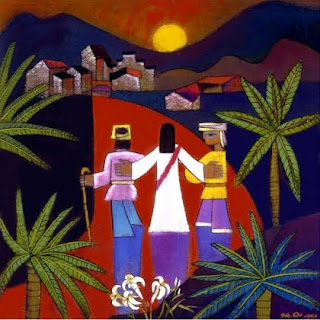 Today is Youth Sunday, and our young people will be narrating an enactment of the story of the
Today is Youth Sunday, and our young people will be narrating an enactment of the story of the disciples on the road to Emmaus, based on Luke 24:13-35. I preached a homily at 8 am on the story. Here it is:
+ + +
“Their eyes were kept from recognizing him.”
What kept them from recognizing who was walking beside them?
What keeps you from recognizing who is walking beside you?
Two men – disciples of Jesus – are walking down a road talking about the astounding, preposterous news from women who tell them that the tomb of Jesus is empty.
As they walk along, a stranger joins them on the road.
“Their eyes were kept from recognizing him,” the gospel account tells us.
I’ve often wondered what kept their eyes from recognizing him.
Was it their grief? Is it their sadness? Or the horror of the crucifixion?
Or was it their doubts and their inability to trust the women who told them about their experience?
Or was it the sheer strangeness of all they were encountering? The gospel does not tell us.
Maybe it was something they carried with them, something very personal? A burden, a disappointment, a failure?* Commentary by Shannon Michael Pater, Feasting on the Word, 3 Easter.
They thought Jesus would be the leader the had waited for, the messiah to redeem Israel. But now their hopes were dashed on the Cross.
Maybe they were just wrapped up in their disillusionment and they just could not see who was walking beside them on the road. They were somewhere stuck in Good Friday.
There is a United Church of Christ pastor in Atlanta, Shannon Michael Pater, who puts it this way: “Easter does not always come in three days. Stones are rolled away, but sometimes we stay in the tomb.”*
The two disciples, engrossed in their darkness, walk on with this stranger, who tells them many things, but still they do not see.
Not until they arrive at an inn, and not until this stranger takes bread, blesses it and breaks it, do they see the Risen Christ in front of them. They see him finally in the act of sharing a simple piece of bread, in sharing a meal. Finally they recognize him in the blessing.
Now they get it.
What gets in your way of seeing?
This story of the two disciples walking on the road to Emmaus puts the question squarely before us. What gets in our way of seeing the Christ in front of us, the Christ in each other, and the Christ in the people around us?
What keeps us from recognizing the Christ in total strangers? Who do we overlook in our daily life and work?
Who brings you blessings, and yet you do not see?
It was not until the disciples on the road to Emmaus were open to the surprise that they finally saw the blessing that was theirs to claim all along.
They caught the newness of this in the very familiar words of a table blessing. The common suddenly became uncommon, the old and familiar became new and different. Nothing for them was ever the same again.
In churches, we commonly talk about our life as on a spiritual journey. We walk on a spiritual path, each our own way, and that is true enough.
The path can take us on an intensely inward journey, encased in the “interior castle,” as medieval mystic Teresa of Avila called it.
Yet, often overlooked is that we are on this journey as a community, with each other. Yes, each of us must walk in our own way, but we are walking together. This does not have to be a lonely path. Even solitary monks gather together to share a meal and escape the interior castle.
When we gather here each Sunday, when we share the bread and wine of our Holy Eucharist, we are like those first two disciples on the road to Emmaus.
Standing at the table, kneeling at the altar rail, we open ourselves to seeing each other, and I pray, open ourselves to the surprise of being blessed by each other.
With these blessings comes a large responsibility. We are called to reach outside ourselves, and touch the hurt and wounds of the world. The walls of our interior castles must have openings that others may see in and we see out.
Our spiritual path can lead us to places most of us would rather not go, and that is why we need the strength of walking together in community.
It is in those difficult places – in hospital rooms, homeless shelters, jail cells, or in an almost forgotten friendship – where we become the hands and face of Christ for someone else on their road to Emmaus.
But to walk that path, we need to ask again: What keeps you from seeing who is in walking beside you? AMEN.
Painting, Road to Emmaus, by He Qi.
No comments:
Post a Comment